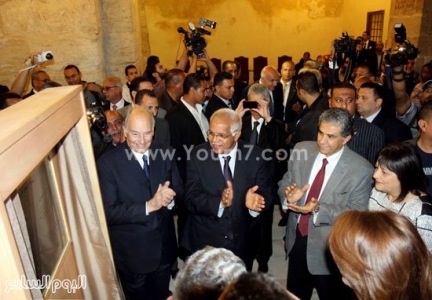Cairo’s Blue Mosque inaugurated after 6-year restoration 2015-05-03
CAIRO: The 14th century mosque of the Amir Aqsunqur, better known as the Blue Mosque, has been opened to the public Saturday after the completion of a six-year renovation project.
The mosque had been closed since 1992 due to damage it had suffered from an earthquake in the same year.
As part of the Al-Darb al-Ahmar Urban Regeneration Program, the Aga Khan Trust for Culture (AKTC) has commenced the renovation work in 2009.
The mosque was inaugurated in presence of Antiquities Minister Mamdouh el-Damaty, the Aga Khan, the Chairman of the Aga Khan Development Network, Cairo governor Galal Saeed.
“The restoration of the Amir Aqsunqur Mosque was executed by a team of 60 to 80 craftsmen and conservators. They had first to remove the temporary supports installed after the 1992 earthquake – and then to implant seismic retrofit measures to protect against future earthquakes. They worked to conserve extensive roofing and facades on the one hand, and delicate marble panels and Iznik ceramic tiles on the other,” said the Aga Khan.
The blue tiles at the mosque’s interior eastern wall lend this mosque its alternative name, Islamic history professor at Minya University Fathy Khourshid told The Cairo Post Sunday.
The World Monuments Fund and the Selz Foundation were also key supporters of the restoration of the Amir Aqsunqur Mosque.
“Covering the Qibla wall from the floor to the ceiling, these tiles are in the style of ceramics manufactured in the Turkish town of Iznik which is famous for blue tiles,” said Khourshid.
Located in Islamic Cairo’s modern district of Al-Darb al-Ahmar between Bab Zuweila and the Citadel of Saladin, “the mosque was a part of a funerary complex, containing the mausoleums of its founder Shams El-Din Aqsunqur, his sons, a number of children of the Mamluk sultan Nasir Mohamed and that of its principal restorer, Ibrahim Agha al-Mustahfizan,” according to Khourshid.
- 6364 reads
 Ismaili.NET - Heritage F.I.E.L.D.
Ismaili.NET - Heritage F.I.E.L.D.